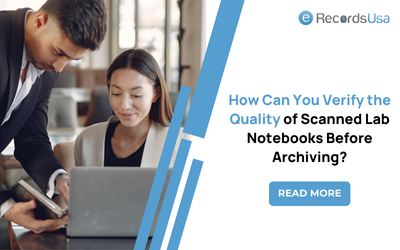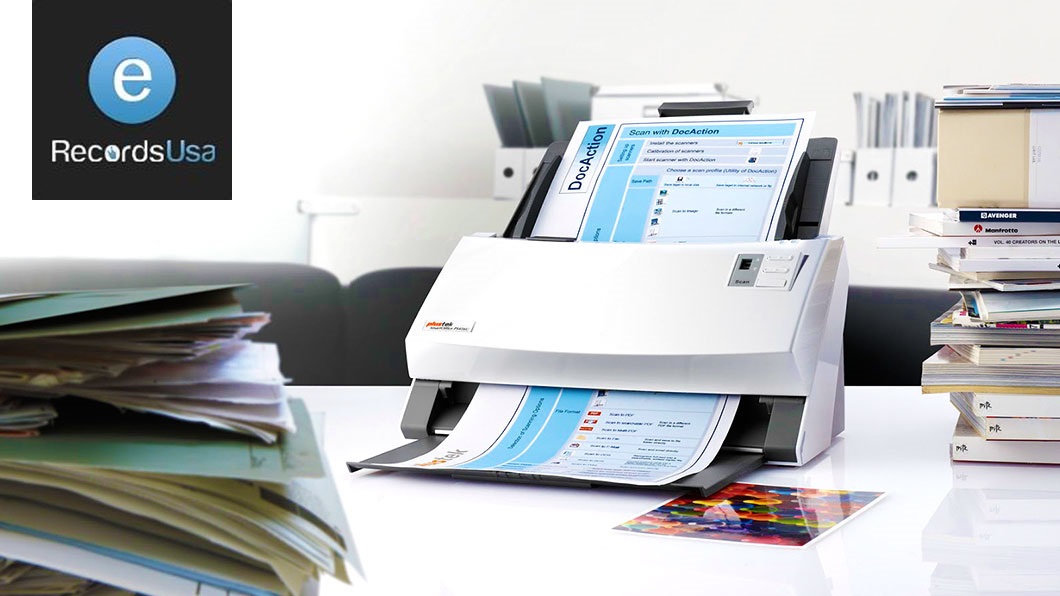Have you ever wondered whether your scanned lab notebooks truly capture every detail needed for research integrity and legal protection? What if a key figure is blurry, a page is missing, or the OCR (Optical Character Recognition) fails to recognize critical text? Poor-quality scans can compromise patent claims, make regulatory compliance difficult, and even hinder future research reproducibility.
As more laboratories transition to digital recordkeeping, verifying the quality of scanned lab notebooks is essential before archiving. Ensuring clarity, completeness, and searchability helps protect intellectual property, supports compliance with regulatory standards, and safeguards scientific discoveries for future use.
In this guide, we’ll explore common scanning issues, step-by-step verification methods, and best practices to ensure high-quality digital lab notebook archiving. Let’s start by identifying the most frequent problems found in scanned lab notebooks.
Common Issues Found in Scanned Lab Notebooks
Before verifying the quality of scanned lab notebooks, it’s essential to understand the most common issues that can arise during the scanning process. Even with advanced scanning technology, errors can occur, leading to data loss, reduced readability, and compromised document integrity. Here are the key problems to watch for:
1. Resolution and Clarity Problems
- Low-resolution scans (below 300 DPI) can result in blurry images, making handwritten notes or fine details difficult to read.
- Shadowing, uneven lighting, or poor contrast can obscure critical information.
- Color distortion can affect images, chemical reaction notes, or highlighted text, leading to misinterpretation of data.
2. Incomplete Scans
- Missing pages can occur if the scanner skips a page or if pages are accidentally left out during batch scanning.
- Cut-off text at the edges of pages can happen due to improper alignment or incorrect scanner settings.
- Cropped images and misformatted pages can lead to loss of critical annotations, making it harder to replicate experiments or validate findings.
3. OCR (Optical Character Recognition) Errors
- OCR inaccuracies can result in garbled or incorrect text, making keyword searches unreliable.
- Misinterpretation of handwritten notes, subscript/superscript scientific notations, and symbols can alter data meaning.
- Formatting inconsistencies can disrupt text flow, making it difficult to read and analyze documents.
4. Metadata and Timestamping Issues
- Missing or incorrect metadata (e.g., researcher name, date, project title) can make retrieval and tracking difficult.
- Inconsistent timestamping may affect compliance with patent laws and Good Laboratory Practice (GLP) guidelines.
- Lack of secure digital signatures or document hashing can raise concerns about document authenticity and prevent proper chain of custody verification.
These issues can significantly impact the usability and legal validity of digitized lab notebooks. Next, we’ll dive into a step-by-step guide to effectively verifying the quality of scanned lab notebooks before archiving.
Step-by-Step Guide to Verifying Scanned Lab Notebook Quality
Now that we understand the common issues in scanned lab notebooks, let’s go through a structured approach to verifying their quality before archiving. Following these steps will ensure that your digital records are clear, complete, searchable, and legally compliant.
Step 1: Checking Image Quality and Resolution
Why It Matters: Low-resolution or distorted scans can make handwritten notes and fine details unreadable, leading to data loss and misinterpretation.
How to Verify:
- Ensure scans are at 300-600 DPI for optimal clarity—600 DPI is recommended for fine handwriting or detailed diagrams.
- Check for blurring, shadowing, and uneven lighting that might obscure important content.
- Use image enhancement tools to adjust brightness, contrast, and sharpness if necessary.
Step 2: Ensuring OCR Accuracy and Searchability
Why It Matters: If OCR fails, text searches become unreliable, making it difficult to retrieve specific information in large archives.
How to Verify:
- Perform a manual spot-check by searching for specific words or phrases in the scanned document.
- Use OCR validation tools or AI-powered text recognition software to detect errors.
- Ensure scientific notations, subscripts, and handwritten content are accurately interpreted.
- Integrate metadata tags into OCR outputs to improve indexing and retrieval.
Step 3: Verifying Completeness and Consistency
Why It Matters: Missing or misaligned pages can compromise research integrity and regulatory compliance.
How to Verify:
- Compare the scanned version with the original lab notebook to ensure all pages are included.
- Check for skipped, misaligned, or duplicated pages using automated verification software.
- Ensure scanned pages maintain the correct sequence and formatting to preserve the document’s logical flow.
Step 4: Confirming Metadata Accuracy
Why It Matters: Proper metadata ensures documents are easily retrievable, legally valid, and traceable in compliance with recordkeeping standards.
How to Verify:
- Check that essential metadata (researcher name, date, project title) is correctly embedded in the file.
- Verify that timestamps are accurate and tamper-proof, ensuring compliance with regulatory standards.
- Use secure hashing techniques to confirm document authenticity and maintain a proper chain of custody.
By following these verification steps, you can ensure your scanned lab notebooks meet the highest standards of quality, usability, and compliance.
Next, we’ll discuss the legal and compliance considerations associated with digitizing and archiving lab notebooks.
Compliance and Legal Considerations in Lab Notebook Scanning
Verifying the quality of scanned lab notebooks is not just about ensuring readability—it’s also about meeting legal and regulatory requirements. Failing to comply with data integrity standards can jeopardize patent claims, research credibility, and compliance with Good Laboratory Practice (GLP) regulations. Here’s what you need to know:
1. Ensuring Legal Admissibility for Patent Claims and IP Protection
- Lab notebooks serve as critical evidence for patent filings and intellectual property (IP) disputes.
- Scanned records must maintain date-stamped authenticity to prove the timeline of discoveries.
- Courts and patent offices often require that digital copies match the original documents with no alterations.
2. How Digital Timestamping and Secure Hashing Prevent Data Tampering
- Implement cryptographic hashing (e.g., SHA-256) to create a digital fingerprint of each scanned document.
- Use timestamping services to prove when the scan was created, ensuring traceability.
- Maintain a chain of custody log that records any modifications or access to the scanned files.
3. Best Practices for Secure Digital Archiving and Long-Term Retention
- Store scanned lab notebooks in compliance-friendly repositories with encryption and access controls.
- Follow compliance guidelines for electronic records management.
- Establish a data retention policy to ensure long-term preservation while staying compliant with industry regulations.
By addressing these compliance factors, laboratories can ensure their digitized records are legally valid, securely stored, and future-proofed for long-term use.
Next, we’ll explore the best practices for ensuring high-quality scanning before archiving.
Best Practices for Ensuring High-Quality Scanning Before Archiving
To prevent scanning errors and maintain the integrity of lab notebooks, laboratories should implement standardized quality control measures. Here are the best practices to ensure high-quality digitization before archiving:
1. Implement a Double-Verification Process
- Adopt a two-step review system, where one person scans the notebook and another verifies the quality.
- Use automated verification tools to detect missing pages, low-resolution scans, and OCR errors.
- Conduct manual spot checks on critical sections to ensure legibility and completeness.
2. Use Manual Review for Error Detection
- Inspect scanned images for clarity, alignment, and completeness before finalizing archiving.
- Ensure handwritten notes, figures, and symbols are correctly captured.
- Compare digital metadata with original records to verify accuracy.
3. Create Standardized Scanning Protocols for Research Institutions
- Define DPI requirements, color settings, and acceptable file formats (e.g., PDF/A for long-term archiving).
- Establish naming conventions and indexing methods to improve document organization.
- Train staff on best scanning practices to maintain consistency across all archived lab notebooks.
4. Regularly Update and Audit Digital Archives for Compliance
- Conduct periodic audits to identify and correct errors in scanned archives.
- Use version control to track changes and updates to digital documents.
- Ensure backup copies are stored in secure, redundant locations to prevent data loss.
By implementing these best practices, laboratories can create a reliable and high-quality digital archive that meets scientific, legal, and compliance standards.
Conclusion: Future-Proofing Research with Verified Digital Lab Notebooks
Verifying the quality of scanned lab notebooks before archiving is not just an extra step—it’s a critical process that ensures research integrity, legal compliance, and long-term accessibility. Poor-quality scans can lead to missing data, legal disputes, and difficulties in retrieving vital research records.
By following a structured verification process—checking image resolution, ensuring OCR accuracy, confirming completeness, and validating metadata—labs can create a reliable, searchable, and legally secure digital archive. Additionally, adopting best practices such as double-verification, standardized scanning protocols, and routine audits strengthens the quality and usability of digitized records.
Final Steps to Ensure Lab Notebooks Are Patent-Ready and Legally Secure
- Always scan at a high resolution (300-600 DPI) to prevent readability issues.
- Use automated and manual verification methods to catch OCR errors and missing pages.
- Maintain secure metadata and timestamps for document authenticity.
- Regularly audit and update digital archives to comply with legal and regulatory standards.
Ensure Your Lab Notebooks Are Archival-Ready with eRecords’ Expert Scanning Services
To ensure the highest standards in lab notebook digitization, consider partnering with a professional lab notebook scanning and verification service. Experts can help implement best practices, enhance searchability, and ensure compliance with patent laws, compliance guidelines, and data security standards.
By investing in quality verification now, you safeguard your research for the future.
Don’t let poor-quality scans compromise your research, intellectual property, or compliance. eRecords’ Lab Notebook Scanning Services ensure your digitized lab records are:
- High-Resolution & Legible – Precision scanning at 300-600 DPI for crystal-clear text and diagrams.
- OCR-Optimized & Searchable – AI-driven OCR ensures accurate text recognition for easy retrieval.
- Legally Compliant & Secure – Digital timestamping, metadata tagging, and secure hashing for regulatory adherence.
- Complete & Verified – Multi-step quality checks to eliminate missing pages, OCR errors, and formatting issues.
Protect your research, streamline compliance, and future-proof your digital archives with eRecords.
📩 Get a Free Consultation Today! Contact our expert team to discuss your lab notebook scanning needs.
📞 Call Us at +1.510.900.8800














